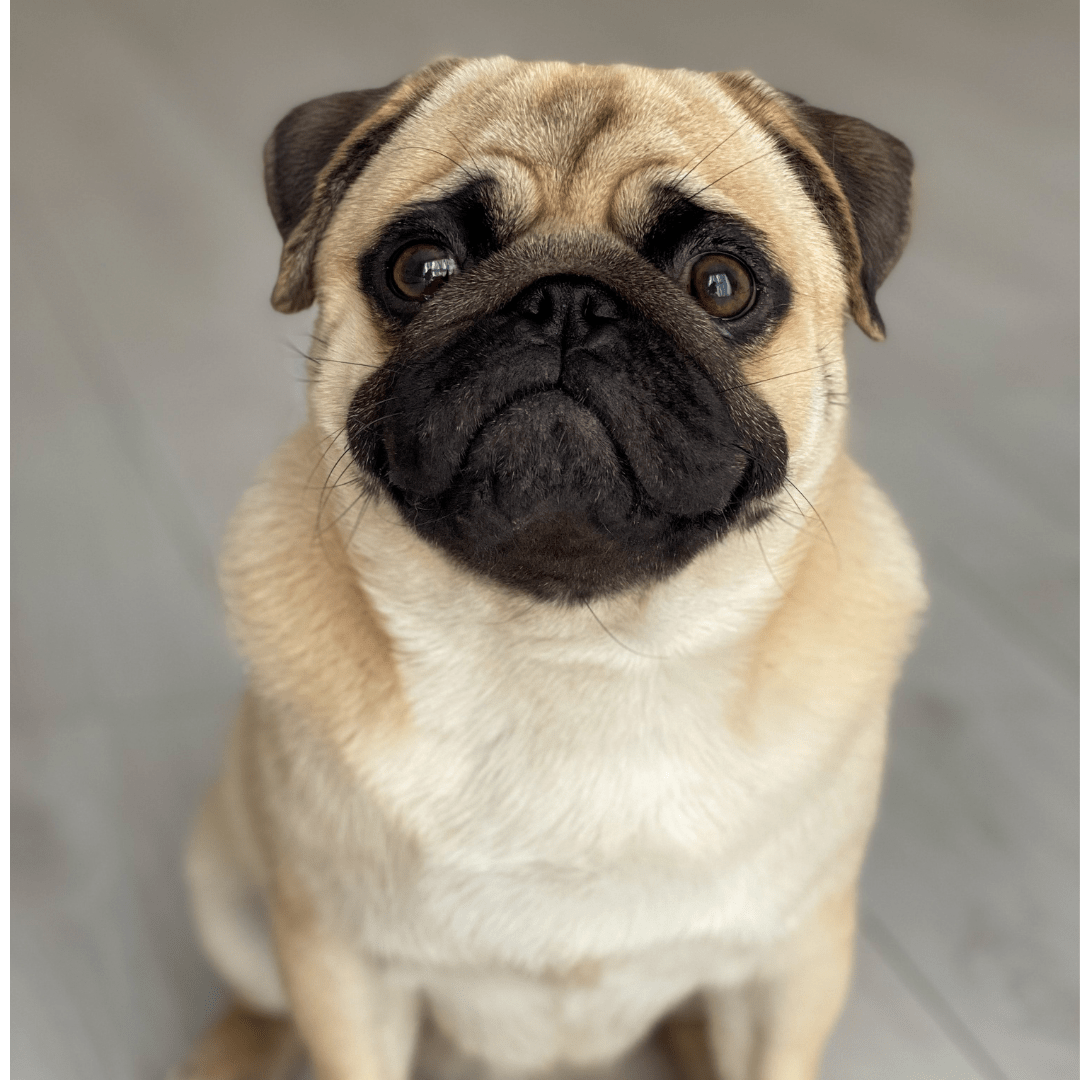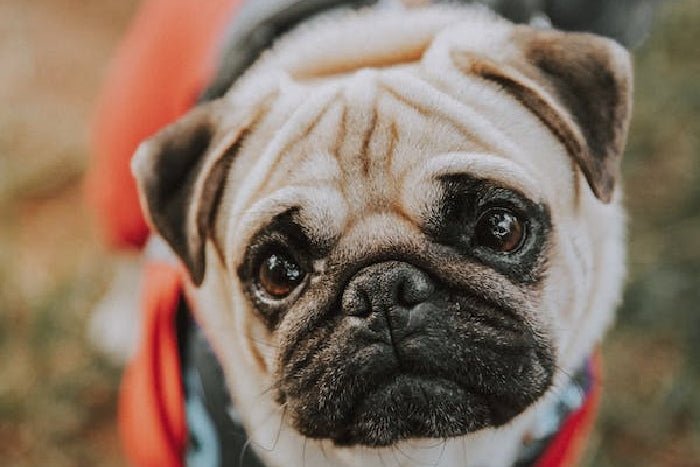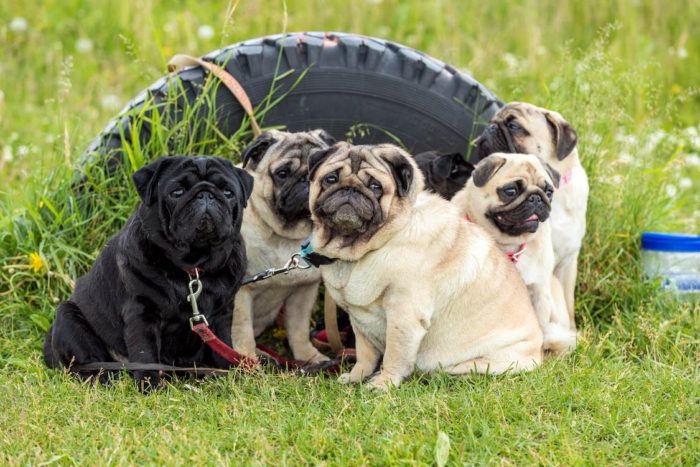Pugs are charming, lovable companions, but behind their wrinkled faces and playful personalities, they’re prone to a frustrating skin condition: hot spots. These inflamed, irritated patches of skin can appear suddenly and spread quickly, leaving pug parents scrambling for solutions.
Understanding why pugs are more vulnerable to hot spots — and how to prevent them naturally — can save your dog from unnecessary discomfort while keeping their skin and coat healthy.
What are Hot Spots?
Hot spots, also called acute moist dermatitis, are painful, inflamed patches of skin that appear suddenly on dogs. They’re red, moist, and often warm to the touch, usually caused by a itch-scratch cycle that spirals out of control.
This means that in pugs, even small irritations (from moisture in wrinkles, allergies, or insect bites) can trigger intense itching → biting/licking → hot spot. Because pug skin is fragile and folds trap moisture, they’re especially vulnerable to this itch-scratch cycle.
- Rapid onset – a hot spot can develop in just a few hours.
- Causes – often triggered by allergies, flea bites, insect bites, moisture trapped in the coat (especially in breeds with wrinkles or dense fur, like pugs), or underlying skin infections.
- Appearance – raw, oozing, circular sores with hair loss in the affected area.
- Progression – once the dog starts licking, scratching, or chewing the spot, bacteria thrive, making the irritation worse.
- Location – they can occur anywhere but are common on the head, neck, hips, and stomach.
Meet Little Guy – Our Inspiration Behind Biogreen Enriched Shampoo

The studious-looking pug you see in glasses is Little Guy, my much-loved Boston Pug who was part of the PawPurity family for nearly two decades. Behind those wise eyes was a dog who battled his share of hot spots and skin flare-ups — challenges pug parents know all too well. Caring for him taught me firsthand how vulnerable this breed can be, but also how much of a difference proactive care and the right grooming products make.
His struggles were the reason I formulated one of our most popular products, → Biogreen Enriched Shampoo. It's made with soothing organic botanicals to calm sensitive skin, and remains a cornerstone of our mission: keeping pugs comfortable, healthy, and happy.
Little Guy’s journey continues to inspire everything we do at PawPurity, reminding us why safe, natural solutions matter.
Why Pugs Are Prone to Hot Spots
While hot spots can appear anywhere, the stomach is a particularly vulnerable area for pugs. Their bellies have thinner skin and less fur, which makes them more sensitive to allergens, moisture, and irritation. When your pug lies on grass, carpets, or even damp bedding, the skin on their stomach can absorb irritants and develop redness or infections quickly.
Common Causes of Stomach Hot Spots in Pugs:
- Allergic reactions to grass, pollen, or cleaning products on floors
- Moisture trapped after playing outside or lying on wet surfaces
- Flea bites or insect irritation
- Food allergies leading to belly rashes
- Excessive licking or chewing, which breaks down the skin barrier
- Wrinkles and folds
Pugs’ adorable wrinkles often trap moisture, dirt, and bacteria. This warm, damp environment becomes the perfect breeding ground for infections, leading to hot spots. Regular cleaning and drying of wrinkles are essential to prevent irritation. For a fast cleanser, PawPurity's Face Stain Remover Shampoo works wonders. It's gentle enough to apply around the eyes and muzzle to clean those folds that give these sweet pug faces such character.
Dense Fur
Their thick coats trap heat and limit airflow to the skin. This combination of warmth and moisture encourages bacterial growth. Regular grooming and brushing help improve circulation and reduce the risk of hot spots. Make sure to towel dry them completely after bathing.
Short Muzzles
Because pugs are brachycephalic (short-nosed), they can struggle to regulate body temperature. Overheating can stress the skin and make hot spots more likely. Always provide a cool environment and avoid overexertion, especially in hot weather.
Environmental Factors and Allergies
Allergens in the Air
Pollen, dust, and mold can trigger skin allergies in pugs. Excessive scratching from these irritants can damage the skin barrier, creating an entry point for bacteria and hot spots. Keeping your home clean, using air purifiers, and limiting exposure to outdoor allergens during peak seasons can help.
Sensitivity to Heat and Humidity
Pugs’ bodies don’t regulate temperature well, making them prone to overheating. High humidity can worsen the problem by increasing skin moisture. Ensure your pug always has shade, cool bedding, and plenty of fresh water.
Pug Behaviors That Worsen Hot Spots
Persistent scratching, chewing, and licking are common pug habits that can worsen minor irritations into full-blown hot spots. Their playful nature can also lead to scrapes and cuts that open the door for infection. Monitoring these behaviors — and addressing skin issues promptly — is key.
Natural Prevention and Treatment Options
Switch to a Gentle, Natural Shampoo
Many pugs react negatively to harsh, chemical-laden shampoos that strip away natural oils and aggravate sensitive skin. Choosing a natural, pH-balanced formula can make a world of difference.
 → Help soothe and protect your pug’s skin with PawPurity Biogreen Enriched Shampoo — formulated with botanicals and pet-safe essential oils to reduce irritation, calm hot spots, and strengthen the skin barrier.
→ Help soothe and protect your pug’s skin with PawPurity Biogreen Enriched Shampoo — formulated with botanicals and pet-safe essential oils to reduce irritation, calm hot spots, and strengthen the skin barrier.
Grooming Routine
Regular brushing removes loose fur, improves circulation, and allows better airflow to the skin. Be sure to clean and dry facial folds after walks, playtime, or meals to prevent trapped moisture from turning into infections.
Veterinary Support
If hot spots persist, a veterinarian may recommend antimicrobial creams, antibiotics, or other treatments. But often, consistent at-home care with natural products is enough to prevent flare-ups before they become severe.
Long-Term Skin Care for Pugs
Creating a healthy living environment is just as important as grooming. Keep your pug’s bedding clean and dry, minimize allergens indoors, and ensure proper ventilation. By combining good hygiene with natural skin care, you’ll greatly reduce the chances of recurring hot spots. Once your pug is back on track, Intensive Nourishing Shampoo is a full-body shampoo that is popular amongst pug parents because it prevents hot spots by keeping the skin healthy using botanicals, vitamins, organic oils and minerals.
Final Word — Protect Your Pug’s Skin Naturally
Pugs may be predisposed to hot spots, but prevention is possible with attentive care and safe, natural grooming products. By understanding their unique vulnerabilities and avoiding harsh chemicals, you can help your pug stay comfortable, healthy, and happy.
→ Support your pug’s skin health naturally with PawPurity Biogreen Enriched Shampoo


